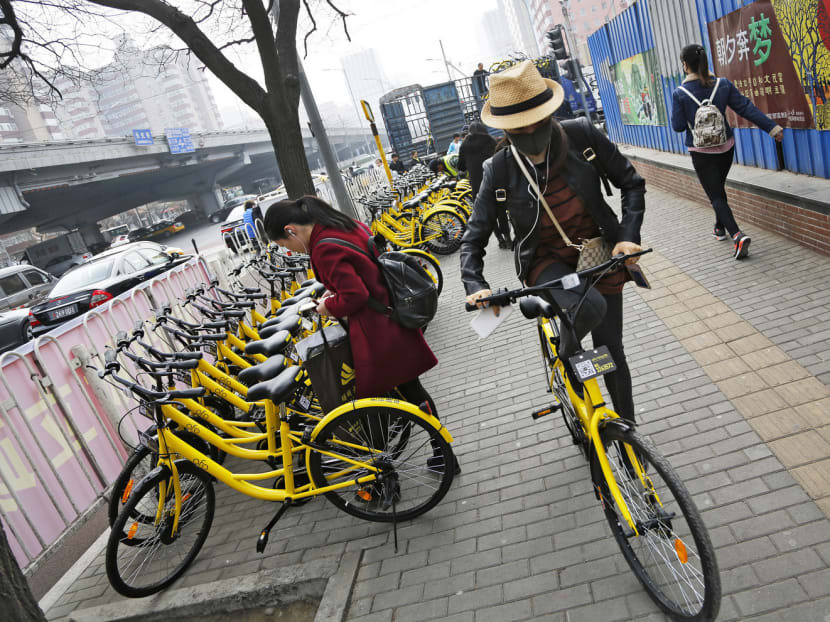Getting a better grip on bike sharing
In the space of just a few months, bike sharing has become a feature of the Singapore commuting scene, as a rash of yellow, orange and silver bicycles pop up across the island.

Commuters in Beijing using ofo bicycles. Bike-sharing operators in Singapore use a dockless system, which can present challenges in a compact and orderly city. Photo: AP
In the space of just a few months, bike sharing has become a feature of the Singapore commuting scene, as a rash of yellow, orange and silver bicycles pop up across the island.
With three bike-sharing firms — Chinese start-ups Mobike and ofo, and Singapore-based OBike — promising to boost their fleets into the tens of thousands by the end of the year, we can expect to see a lot more of them in our streets and parks.
Cities such as New York, London and Paris have been operating dock-based bicycle-sharing schemes for several years with varying degrees of success.
These rely on fixed electronic racks for users to pick up and return bikes — a system favoured by city authorities because it forces users to park their bikes in designated areas without cluttering up public spaces.
The model used by the new operators here in Singapore, however, is to go dockless. Pioneered in China and dubbed “the Uber for bikes”, this free-floating model uses smartphone apps and global positioning system tracking to allow users to rent and drop off bikes on demand wherever they choose.
The dockless model brings its own particular challenges, especially in a compact, high-density city like Singapore that covets order. This model has seen rapid growth in China over the past year or so, with around a dozen firms despatching millions of bicycles onto the streets of major Chinese cities.
This has led to a backlash from city authorities fed up with scores of bikes clogging up pavements, parks and other public spaces. In Beijing and Shanghai alone, thousands of share bikes have been impounded and regulators have tightened up laws on the use of the bikes.
Here in Singapore, regulators are also starting to step in. Amid growing complaints of indiscriminately- parked bikes and careless riders, the Land Transport Authority has said it will create more official bike parking areas, while several town councils have started to enforce rules on where bikes can be used and stored.
All 15 town councils run by the ruling People’s Action Party are in the midst of developing a common set of regulations for bicycle sharing, parking and riding, co-ordinating chairman of PAP Town Councils Dr Teo Ho Pin said last month. As operators push ahead with expansion plans, we can expect more regulation as the sheer volume of bikes on the streets grows.
Fleets of bikes running into the tens of thousands take up a lot of room in an already crowded urban setting.
At the same time, bike-sharing firms are exploiting a public resource — roads and sidewalk space — for private business gain.
As such, companies and regulators will need to work out between themselves an appropriate level of compensation for this usage.
One approach might be in the form a fee per bike in each operator’s fleet. For example, car2go in Washington DC, a free-float car-sharing operator, pays the city’s transport regulator almost US$3,000 (S$4,150) per year for each of its approximately 450 Smart cars, because they are all parked on public streets when not in use.
In the case of bike-sharing, such a fee-based approach would incentivise operators to calibrate their fleet sizes and manage their deployment wisely.
Regulators could use the fees collected to oversee and support the operations of bike- sharing including, for example, allocating and maintaining designated share-bike parking areas near MRT stations, HDB blocks and other popular areas such as shopping malls and food courts.
This would help integrate bike sharing within the existing public transport infrastructure and encourage its use for so-called “last-mile connectivity”.
Meanwhile, firms should also look at how incentives and penalties can be better employed to educate users in sharing etiquette.
If bike sharing is to be successful, operators and regulators need to cooperate and coordinate, avoiding the more confrontational situation we have seen develop in some parts of China.
ABOUT THE AUTHOR:
He Long is an Assistant Professor in the Department of Decision Sciences at National University of Singapore (NUS) Business School. The opinions expressed are his own.






